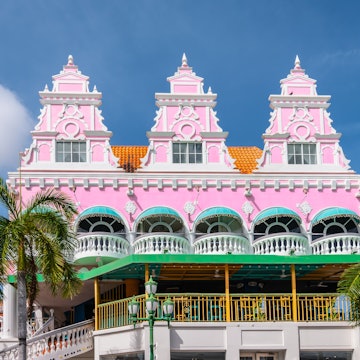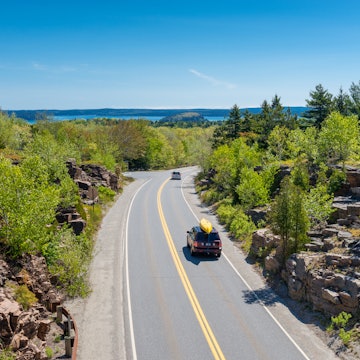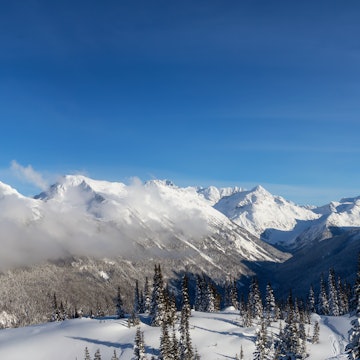

The outdoor scenes are the main venues for emerging music acts at the FME festival in Quebec © Festival de musique émergente
The FME music festival in Quebec, Canada, just might be the most eclectic music festival in North America, with up to 70 live performers in a variety of genres and a ’gram-able array of art installations. But it’s what happens away from the announced venues that really makes the festival unique.

In one exhilarating weekend in late August or early September each year, the small town of Rouyn-Noranda (pop 42,000) swells to double that size as revelers from all over the world pour in. They’re coming to see their favorite emerging artists on stage, but also at secret pop-up shows in unexpected places, which are announced only at the last minute via a smartphone app.

What makes it special?
Founded in Quebec, Canada in 2003 by Jenny Thibault and Sandy Boutin, the Festival de Musique Emergente (FME) was designed to support new musicians and promote Canadian talent to the world. That has led to a mixture of English and French acts, from family-friendly singalongs, moody jazz numbers, exciting emerging talent, fresh hip hop crews and thundering metal bands to the old familiar favorites.
They play at traditional outdoor concert spaces as well as inside clubs, bars and breakfast joints, in churches, at the botanical gardens, at a garage, down alleyways and anywhere music can be made. An innovative app keeps festival-goers up-to-date on all the ‘secret’ shows, a practice started almost a decade ago:
‘It was Random Recipe, a band from Montreal,’ Thibault says. ‘After their show they were so high and excited they decided to go to Morasse Poutine to do a surprise show for 200 people.’
That show at the festival-favorite restaurant was a hit – and suddenly other bands wanted to keep playing after their sets as well. It grew into a tradition that has become one of the most anticipated features of the festival. The last-minute announcements amp up the excitement, as the app sends alerts throughout the weekend to let revelers know where to head next.

Music, art and culture
Another recurring feature of the festival has been the way music, art and the local indigenous culture have been woven together into one celebration of expression.
Attendees can purchase a ‘festival passport,’ granting access to all the different performances. Then they simply walk from one nearby venue to another – bopping from outdoor festival grounds to intimate coffee shops – to experience a variety of entirely different sounds.
Along the way, large, colorful murals adorn the side of buildings and businesses throughout town. They’re carefully planned each year by Artistic Director Karine Berthiaume, and crafted by a committee of local artists and creators.
And starting in 2017, FME organizers have collaborated with the indigenous Anicinabe people to share a cultural exchange through dance presentations and the Pikogan Pow Wow. There are nine Quebec Algonquin indigenous communities in the region and Thibault sees the festival as a way to make connections between these diverse groups. ‘Through music and art, we can discover each other,’ she says.

Technology adds to a magical experience
In addition to announcing the secret pop-up concerts, the festival app is also a way for the organizers to have ‘constant communication with festival goers,’ Thibault says. The app can also be pre-loaded with cash to make drinks, T-shirt, and album purchases much easier. The FME was one of the first festivals to adopt such a cashless system.
Festival-goers bring their own plastic mugs from show to show, with the smartest using a carabiner to attach the empty mug to their belt. Those who come back year after year build up quite a collection of official FME drink cups.
And come back they do. Because quirks and apps aside, many festival-goers find that they fall in love with this unpretentious, friendly haven for artists, creators and music lovers.
Some of the most notable musicians to have performed at the festival in years’ past include hometown star Richard Desjardins – who played for free to support the town. And festival founder Boutin wistfully remembers one very special performance by a famous Montreal singer-songwriter:
‘We did a show of Patrick Watson near the old mine with just a piano and two speakers and 600 people came to listen,’ he says. ‘It was magic – all the people were so quiet.’

Make it happen
When: Late August or early September
Where: About a 7-hour car drive northwest from Montreal, Rouyn-Noranda is on Highway 117.
What to Eat: Chez Morasse has been operating since 1969 and is open 24 hours, serving a huge variety of takes on a Quebec favorite: french fries and gravy poutine. For a more refined experience check out Le Cachottier.
Where to stay: The Hôtel Gouverneur Le Noranda offers elegant rooms and suites while the Jardin Spa has a full-service spa and hammam (similar to a steam room). For a more rustic experience, choose from among many nearby campgrounds, including Kanasuta.
Costs: There are lots of free shows and events during the weekend with headline shows and special performances costing from $10 CAD and up. Passport tickets give visitors the chance to see as many performances as possible, ranging in price from $110 CAD and up.
Beyond the festival: The town of Rouyn-Noranda has lots of little gift shops and art galleries to peruse. Explore the larger area of Abitibi-Temiscamingue by visiting Parc National Aiguebelle, and crossing the 22m high suspension bridge which stretches across two rivers, flowing in different directions. Then drive about an hour to Val D’or to visit the gold mines at La Cite de l'Or, 90m underground.
















